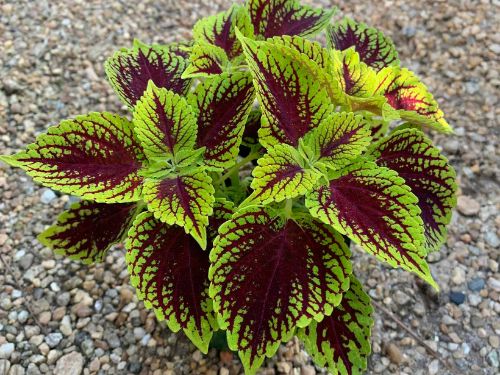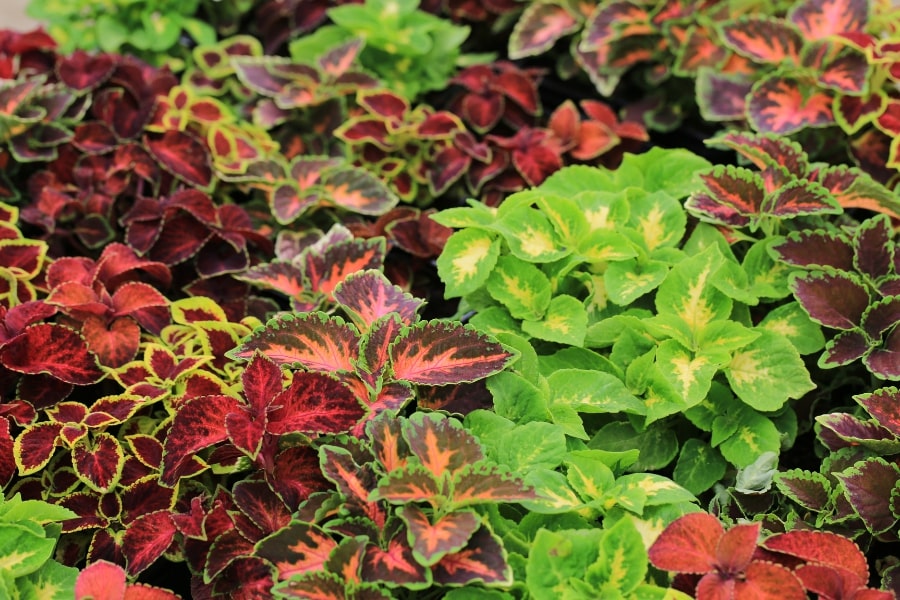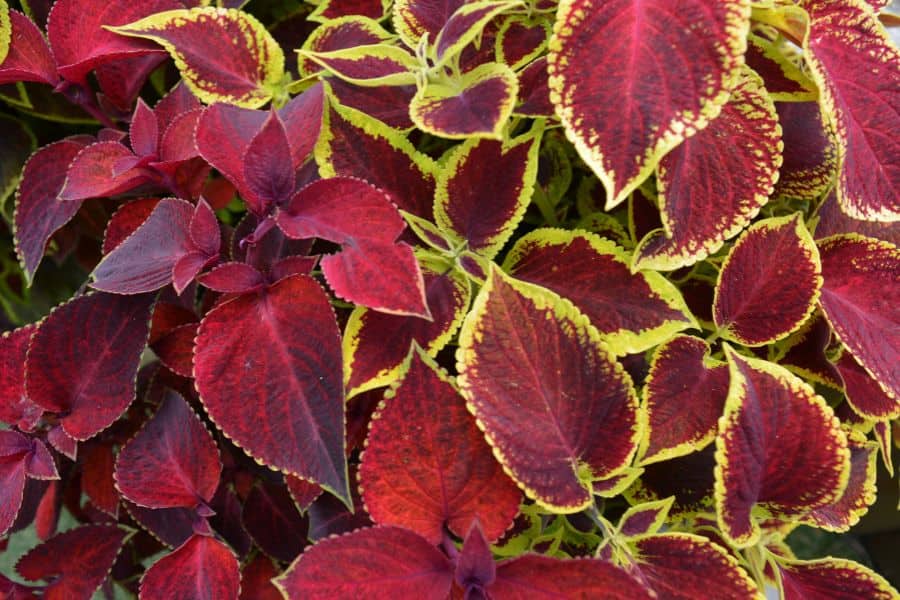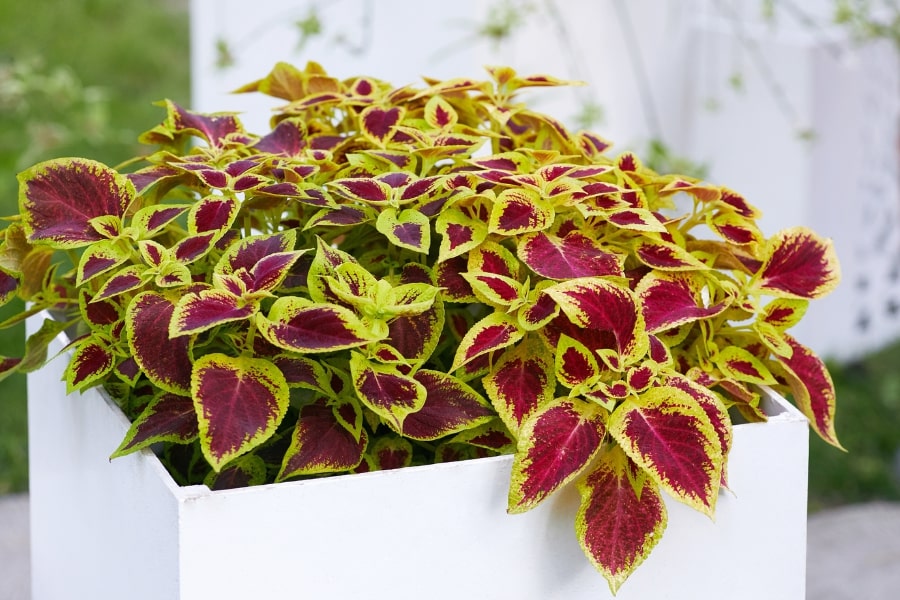Scientifically known as Plectranthus scutellarioides, Coleus is a fascinating plant known for its foliage and diverse colors. You can explore an endless palette of colors and patterns with Coleus, allowing your creativity and garden to thrive with vibrant beauty. The plant has earned a well-deserved place in the hearts and gardens of many, due to its unique size and shape, striking leaves, adaptability to various growing conditions, and an array of popular varieties. Coleus plants are typically compact and bushy, reaching a height of about 1 to 3 feet and spreading outwards to create a full, rounded form.

Our Selection of Coleus
There is a vast array of popular Coleus varieties available, each offering its own unique blend of colors and patterns. Some of the most popular varieties that we sell at Martin Garden Center include Alabama, Defiance, Pat Martin, Pineapple, Sangria, Trailing Burgundy, Trailing Plum, and Wasabi.
We are growing over 20 Coleus varieties in 2025:
- Burgundy Wedding Train
- ChargedUp Vulcan
- Down Town Greenville
- Down Town Santa Monica
- Down Town Vegas Neon
- Flame Thrower Habanero
- Flame Thrower Salsa Serrano
- Flame Thrower Salsa Verde
- Flame Thrower Spiced Curry
- Ignea David Verity
- Main Street Beale Street
- Main Street Chartres Street
- Main Street Rodeo Drive
- Main Street Venice Boulevard
- Party Time Pink Berry
- Skeletal
- Stained Glassworks Velvet
- Terra Nova Electric Slide
- Trail Blazer Glory Road

Growing and Caring For Coleus
Coleus is known for its adaptability to various growing conditions, making it a versatile choice for indoor and outdoor cultivation. These plants thrive in well-draining soil and prefer bright, indirect light. They can tolerate some direct sunlight, but intense heat or prolonged exposure to the sun may cause the colors of the leaves to fade. Coleus also prefers moderate humidity levels and temperatures between 60°F and 75°F (15°C and 24°C).
When it comes to watering Coleus, consistency is key. Keep the soil evenly moist, but avoid overwatering, as Coleus plants are susceptible to root rot in soggy conditions. Mulching around the base of the plant can help retain moisture and suppress weeds. Also, Coleus plants should be regularly fertilized with a balanced, water-soluble fertilizer to promote healthy growth and vibrant foliage.
To encourage bushy growth and prevent legginess, pinch back the growing tips of Coleus plants regularly. This pruning technique promotes a more compact shape and stimulates the growth of new leaves, resulting in a fuller, more lush plant. Coleus plants are generally low maintenance, but they should be watched for pests such as aphids and spider mites, especially when grown indoors. These pests can be easily controlled with insecticidal soap or neem oil.
Coleus is often grown as annual in colder climates, but it can be perennial in warmer climates. To overwinter Coleus plants, bring containers indoors before the first frost or take cuttings to root indoors for replanting in the spring. For more information on overwintering Coleus, check out our guide on How to Grow and Care for Coleus Indoors. With proper care and attention, Coleus plants can provide months of colorful foliage, adding beauty and interest to any garden or indoor space.
Leaves & Flowers
One of the most captivating features of Coleus is its spectacular leaves. The leaves are usually large and come in many shapes, including ovate, heart-shaped, or lanceolate. In addition, the edges of the leaves can be smooth or serrated, adding to the overall visual interest. However, what truly sets Coleus apart is the incredible diversity of leaf colors and patterns. From bold and vibrant combinations of red, yellow, orange, and green to mesmerizing blends of purple, pink, and cream, coleus leaves come in an endless array of striking patterns and shades.
While coleus plants are primarily grown for their foliage, they produce flowers, although they are not the main attraction. The flowers are small and often insignificant compared to the vibrant leaves. They typically appear as spikes or clusters of tubular blooms in shades of white, lavender, or blue. However, many gardeners prefer to pinch off the flowers to encourage the plant to focus its energy on producing even more stunning foliage.

Uses in the Garden
Coleus is a standout foliage plant that brings bold color and texture to gardens, containers, and shaded landscapes. With its vibrant leaves in shades of red, pink, orange, green, and purple, Coleus adds striking contrast to flower beds, borders, and mixed plantings. It thrives in both sun and shade, depending on the variety, making it a versatile choice for filling gaps in the garden. Whether planted as a backdrop for flowering annuals or as a statement piece in shaded beds, Coleus provides season-long interest with minimal maintenance.
Beyond garden beds, Coleus excels in containers, where its richly colored foliage spills over pots, hanging baskets, and window boxes. It pairs beautifully with other shade-loving plants like impatiens, begonias, and ferns, creating lush, layered displays. Sun-tolerant varieties can also be used in bright locations alongside petunias, sweet potato vines, and ornamental grasses. Regular pinching encourages bushier growth, while removing flower spikes helps maintain the plant’s vibrant foliage. Whether used as a border plant, a container thriller, or a shade garden staple, Coleus brings bold color and texture to any landscape.

Frequently Asked Questions
How To Propagate Coleus?
Propagating coleus can be done through stem cuttings. Start by selecting a healthy and mature coleus plant. Use sharp scissors or pruning shears to take cuttings about 4 to 6 inches long, ensuring each cutting has several leaves. Remove the leaves from the lower portion of the cutting, leaving only a few leaves at the top. Dip the cut end in rooting hormone to encourage root development.
Next, plant the cuttings in a well-draining soil mix and keep them moist. Place the cuttings in a warm and bright location, but avoid direct sunlight. After a few weeks, the cuttings should develop roots, and once they have established a root system, they can be transplanted into individual pots or directly into the garden.
Are Coleus Annuals or Perennials?
Coleus plants are typically grown as annuals in the Upstate, but can be easily propagated for the following year.
Is Coleus Poisonous To Cats & Dogs?
The ASPCA lists coleus as toxic to both cats and dogs. The poisonous principle in coleus is colein, which can cause gastrointestinal upset, including vomiting and diarrhea, as well as potential dermatitis or skin irritation in cats. Keep coleus out of reach of pets or choose cat-safe alternatives for indoor and outdoor landscaping. If you suspect your cat has ingested coleus or is showing signs of illness after contact with the plant, contact your veterinarian or a poison control hotline for guidance.
